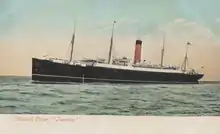.jpg.webp) Cunard Liner Ivernia | |
| History | |
|---|---|
| Name | SS Ivernia |
| Namesake | Iverni |
| Owner | Cunard Line |
| Builder | Swan Hunter, Tyne and Wear |
| Launched | 21 September 1899 |
| Fate | Torpedoed and sunk, 1 January 1917 |
| General characteristics | |
| Type | Ocean liner |
| Tonnage | 13,799 gross register tons (GRT) |
| Length | 600 ft (180 m) |
| Beam | 64 ft (20 m) |
| Propulsion | Steam quadruple-expansion engines geared to twin propellers |
| Speed | 15 knots (28 km/h; 17 mph) |
| Capacity |
|
| Notes | sister ship to RMS Saxonia |

SS Ivernia was a British ocean liner owned by the Cunard Line, built by the company Swan Hunter & Wigham Richardson of Newcastle upon Tyne, England, and launched in 1899. The Ivernia was one of Cunard's intermediate ships, that catered to the vast immigrant trade. Together with her sister ship RMS Saxonia, the Ivernia worked on Cunard's service from Liverpool to Boston and then later on the immigrant run the Cunard Line had established from Fiume and Trieste to New York City.[1]
Following the outbreak of World War I in August 1914 the Ivernia was hired by the British government as a troop transport. In autumn of 1916, William Thomas Turner (made famous for being the captain of RMS Lusitania at the time of her sinking) was given command.[2]
On 1 January 1917, the Ivernia was carrying some 2,400 British troops from Marseille to Alexandria, when at 10:12 am she was torpedoed by the German submarine UB-47 58 miles south-east of Cape Matapan in Greece, in the Kythira Strait. The ship went down fairly quickly with a loss of 36 crew members and 84 troops. Captain Turner, who had been criticised for not going down with the Lusitania (even though he had believed he was the last person on board), remained on the bridge until all aboard had departed in lifeboats and rafts "before striking out to swim as the vessel went down under his feet."[2]
HMS Rifleman rescued a number of survivors and armed trawlers towed the bulk, who had taken to lifeboats, to Suda Bay in Crete.
Today Ivernia Road in Walton in Liverpool still bears the name of the doomed vessel.
References
- ↑ Neil McCart, Atlantic Liners of the Cunard Line (1990), pp. 35-36.
- 1 2 Gould, James E. (7 May 2015). "Why Should Captains Go Down With Their Ships?". The Atlantic Monthly. Retrieved 8 May 2015.
External links
- Photograph of Ivernia
- Ivernia history Archived 9 October 2016 at the Wayback Machine
- Wrecksite